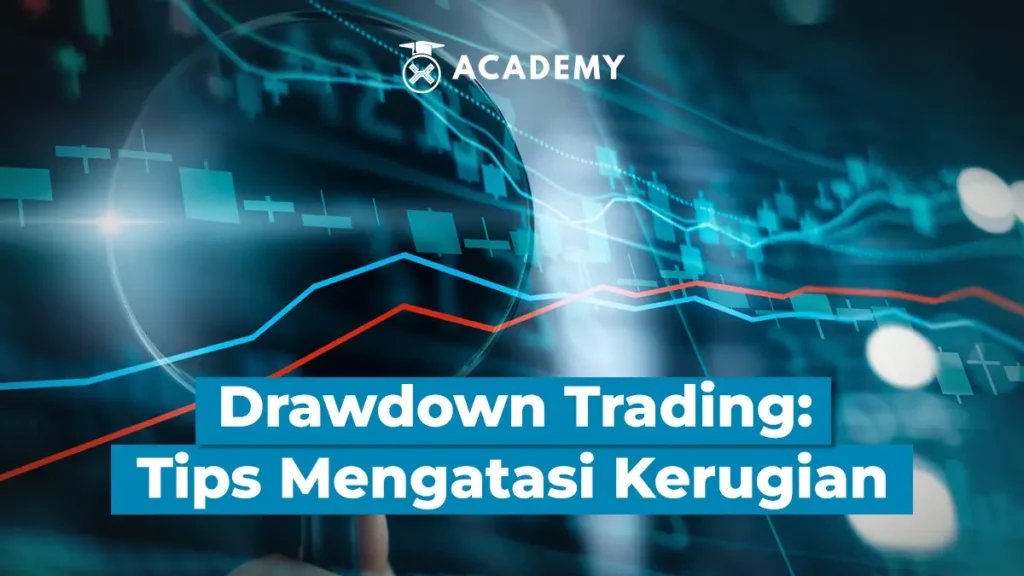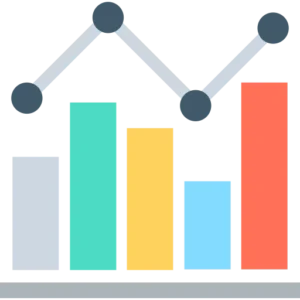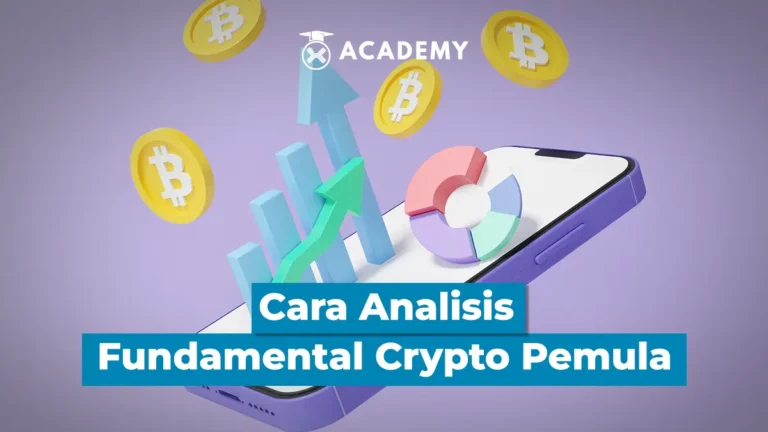When entering the world of trading and investing, you’ll encounter many terms you may not be familiar with. One important term is “drawdown.”
Drawdown is a commonly used term in trading and investing. It refers to the decline in the value of a portfolio or equity from its highest peak. It represents the difference between the highest value ever achieved and the current lowest value.
In the trading context, drawdown indicates the maximum loss incurred before the value returns to a higher level.
Check out the following review to better understand drawdown in trading, from its types, functions, and influencing factors to tips on how to deal with it.
What is Drawdown in Trading?
Drawdown is the drop in asset value or price from peak to trough in an investment, trading account, or fund. Drawdown measures the historical risk of different investments, compares fund performance, or monitors individual trading performance.
For example, if a trading account has a balance of $10,000 and then drops to $9,000 before rising back above $10,000, the account has a 10% drawdown.
Understanding drawdown is important for traders and investors because it gives them an idea of the risk associated with a trading or investment strategy. By knowing drawdown, traders and investors can also evaluate the performance of a portfolio or investment fund.
Types of Drawdown

There are three types of drawdown known today: absolute, maximum, and relative. The following is an explanation of each, namely:
1. Absolute Drawdown
Simply put, an Absolute Drawdown is a drawdown measured in absolute value, usually expressed in currency units.
It is calculated as the difference between the initial trading capital and the lowest value reached without considering unrealized profits. Traders usually use this data to understand the initial risk of their trading activity.
2. Maximum Drawdown (MDD)
This type of drawdown is very popular among traders because the Maximum Drawdown (MDD) measures the decrease in the value of the initial capital after taking into account losses from consecutive trades. Traders usually associate the term drawdown with MDD.
MDD data is expressed as a percentage of accumulated unrealized losses. The deeper the drawdown, the larger the MDD percentage. A high MDD percentage increases the chances of a margin call, which means a request to increase capital.
The assumption is that as long as the price level has not returned to the initial price, the correction may continue, and sufficient time is needed to return the value to its original position.
3. Relative Drawdown
This type of drawdown reflects the temporary state of trading activity. Its value is calculated as the ratio between initial capital plus unrealized profit as the numerator and initial capital plus unrealized loss as the denominator.
Unlike the Maximum Drawdown (MDD), a large relative drawdown value indicates good asset or portfolio performance. This is because the relative calculation uses a ratio expressed as a percentage.
The larger the numerator, the higher the percentage. Conversely, the larger the denominator, the lower the percentage. In short, this relative drawdown percentage reflects the level of profitability of a portfolio or asset.
This variable is often used to evaluate the performance and effectiveness of your trading system.
Functions of Drawdown
Several functions of drawdown are important to know, including the following:
1. Risk Measurement
Drawdown helps identify financial risks in investments.
2. Performance Comparison
Drawdown is used to compare performance between different investments or trading strategies.
3. Personal Performance Monitoring
Traders can monitor their trading performance by observing the drawdown that occurs.
Factors Affecting Drawdown
Some factors that can affect drawdown include the following:
Trading Strategy
The trading strategy applied has a significant impact on the drawdown. More aggressive or high-risk strategies tend to result in greater drawdowns than more conservative strategies.
Market Volatility
Market volatility also plays a role in determining the amount of drawdown. A more volatile market has the possibility of greater price movements, leading to greater drawdowns.
Risk Management
How a trader or investor manages risk can also affect drawdown. Without effective risk management, drawdowns can become larger and threaten portfolio stability.
Economic and Geopolitical Conditions
Unexpected economic and geopolitical events can trigger sharp fluctuations in the market. Economic crises, changes in government policies, or geopolitical tensions are some examples of events that can cause a significant drop in value.
How to Calculate Drawdown
Here is a simple formula for calculating drawdown as a percentage, which is:
Drawdown (DD) % = ((Pmax – Pmin) / Pmax) * 100
Where:
- Pmin = Lowest value (valley)
- Pmax = Highest value (peak)
Here is a simple example to explain drawdown:
Suppose a trader has an initial portfolio worth $50,000. It rises to $60,000 within a few months, reaching its highest peak. However, the market experienced a large correction, and the portfolio value dropped to $45,000.
The drawdown is $15,000 ($60,000 – $45,000) or 25% of the peak ($15,000 divided by $60,000, then multiplied by 100%).
Why Do Traders Need to Know Drawdown?
Facing a drawdown is a very unpleasant situation for a trader. No one wants to see the value of their trading asset fall from its peak. However, there are many reasons why this data is so useful for traders, including:
Measuring asset risk historically
Drawdown data is very useful in measuring the historical risk of an asset instrument. That way, traders can compare it to the risk of other instruments before choosing an asset to trade.
Assess trading performance through drawdown
Investors can evaluate their asset trading performance through drawdown data. This is because it measures the potential consecutive losses during investment or trading based on historical data. Drawdown data can then be used as a trading evaluation tool.
Representation of market volatility and trading effectiveness
This data also reflects the level of market volatility, trading effectiveness, and asset diversification preferences of a trader.
Tips for Dealing with Drawdown

Asset price fluctuations are an inevitable part of trading. It’s not always the case that asset prices will move in line with expectations, so drawdowns are a common experience for all traders.
However, you don’t need to worry when facing it. It can be overcome if you prepare your trading carefully. Then, what preparations are needed to deal with this situation? Here are some tips, namely:
Determining Tolerable Drawdown
Instead of panicking, it’s wise to determine the maximum drawdown limit you can tolerate from the start. In this case, you can use the concept of maximum drawdown (MDD) and the recovery process.
When calculating drawdown, you only need to measure how much the average percentage decline in the asset price is from its highest peak to its lowest point within a certain period, for example, the last month, two months, or three months.
This average figure can be used as a guide to set an acceptable limit for the asset’s price decline. After measuring the unrealized loss, the next step is to measure the recovery value.
The calculation method is the same: looking at the average increase in asset value from its lowest point to its highest peak within a certain period. However, you need to understand the concept of recovery first.
A common mistake in interpreting drawdown data is to assume that the recovery rate is only measured by the asset’s price movement back to its initial value.
In fact, the concept of recovery also includes opportunity cost, which is the time traders “waste” while holding an asset whose value is undergoing a correction.
As such, your target recovery value should be greater than the drawdown value. The bigger the correction, the bigger the growth in asset value you need to maintain your initial capital value and replace the “time cost”.
For example, if the drawdown is 10%, you need a recovery rate of 11%. However, if it reaches 20%, you need to set a higher recovery target, for example, 25%.
Based on the concept of drawdown and recovery, traders usually set a maximum limit for drawdown, known as maximum drawdown (MDD), of no more than 20%. This is because restoring the value of an investment and increasing it by 25% takes years.
An MDD of 20% is usually recommended for those who started investing at a young age. However, the recommended MDD for portfolios with a short time horizon is 10%.
Determining the Stop Loss Point
After setting the maximum limit for the asset’s drawdown, the next step is determining the Stop Loss point.
In this case, you can set your Stop Loss point between your entry point and your MDD value if you don’t feel mentally prepared for the drawdown.
However, you can also set a Stop Loss at the set MDD point if the asset price is likely to continue its correction.
Difference between Drawdown and Maximum Drawdown
The following is a table of the differences between Drawdown and Maximum Drawdown that you need to know, namely:
| Aspect | Drawdown | Maximum Drawdown (MDD) |
| Definition | A decline from the highest point to the lowest point over some time for an investment or trading account. | The largest loss that occurs from peak to trough over a period of time. |
| Measurement | Measures how much the value of a portfolio or account has fallen from its highest point. | Measures the maximum loss from the highest to the lowest point before reaching a new high. |
| Frequency | It may occur multiple times, depending on fluctuations in the value of the portfolio or account. | Occurs once during a certain period, i.e., when the largest loss occurs. |
| Context | Provides an overview of the temporary decline in portfolio/account value. | Provides an overview of the worst risks to impairment that may be faced. |
Conclusion
In conclusion, drawdown measures the decline in value from peak to trough within a given period, giving an idea of the downside risk that a trader or investor may face.
Drawdown management is important for traders and investors as it can help them gauge risk, evaluate portfolio performance, and plan effective trading strategies.
By understanding drawdown, traders and investors can identify potential points where maximum risk of loss is possible and take steps to mitigate the impact.
As such, drawdown management can be a powerful tool in helping traders and investors make wiser decisions and succeed in trading and investing.
Invest in Crypto Assets Easily, Safely, & Profitably on INDODAX
Well, now you understand what drawdown is in trading, from the types, functions, and factors that affect it to tips on dealing with it.
Furthermore, those interested in making crypto investments easily, safely, and profitably, from buying bitcoin and ethereum to other crypto assets, can buy them on the INDODAX Market.
It is important to know that INDODAX is the country’s best and most trusted crypto asset trading platform to date.
As a pioneer of crypto asset trading in Indonesia, INDODAX continues to be committed to providing investors with easy access to the crypto asset market.
As a disclaimer, it is also important to remember that investing in crypto assets is the same as other investments, which are not avoidable risks.
The risks include fluctuations in the asset’s value and its high volatility level.
Therefore, it is better to do in-depth research before investing in crypto assets or join the Crypto Academy program on INDODAX Academy to gain more comprehensive knowledge.
So, let’s start investing in crypto assets now only with INDODAX and enrich your knowledge by joining the Crypto Academy!





 Polkadot 8.92%
Polkadot 8.92%
 BNB 0.40%
BNB 0.40%
 Solana 4.83%
Solana 4.83%
 Ethereum 2.37%
Ethereum 2.37%
 Cardano 1.35%
Cardano 1.35%
 Polygon Ecosystem Token 2.12%
Polygon Ecosystem Token 2.12%
 Tron 2.85%
Tron 2.85%
 Market
Market


